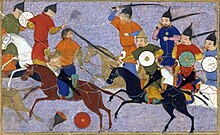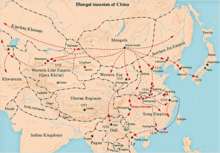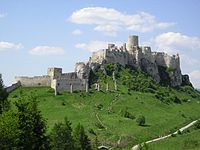Mongol invasions and conquests
| Mongol invasions and conquests | |||||
|---|---|---|---|---|---|
 Expansion of the Mongol Empire 1206–94 | |||||
| |||||
| Casualties and losses | |||||
| Total dead:20–57 million[1][2][3] | |||||
TheMongol invasions and conqueststook place during the 13th and 14th centuries, creating history's largest contiguous empire, theMongol Empire(1206–1368), which by 1260 covered large parts ofEurasia.Historians regard theMongol devastationas one of the deadliest episodes in history.[4][5]
Overview
[edit]The Mongol Empire developed in the course of the 13th century through a series of victorious campaigns throughout Eurasia. At its height, it stretched from thePacifictoCentral Europe.In contrast with later"empires of the sea"such as theEuropean colonial powers,the Mongol Empire was aland power,fueled by the grass-foraging Mongol cavalry and cattle.[a]Thus most Mongol conquest and plundering took place during the warmer seasons, when there was sufficient grazing for their herds.[6]The rise of the Mongols was preceded by 15 years of wet and warm weather conditions from 1211 to 1225 that allowed favourable conditions for the breeding of horses, which greatly assisted their expansion.[7]
As the Mongol Empire began tofragmentfrom 1260,conflict between the Mongols and Eastern European politiescontinued for centuries. Mongols continued to ruleChinainto the 14th century under theYuan dynasty,while Mongol rule inPersiapersisted into the 15th century under theTimurid Empire.InIndia,the laterMughal Empiresurvived into the 19th century.
History and outcomes
[edit]Central Asia
[edit]
Genghis Khanforged the initialMongol EmpireinCentral Asia,starting with the unification of the nomadic tribes of theMerkits,Tatars,Keraites,Turks,NaimansandMongols.The BuddhistUighursofQochosurrendered and joined the empire. He then continued expansion viaconquest of the Qara Khitai[8]andof the Khwarazmian Empire.
Large areas ofIslamic Central Asiaandnortheastern Persiawere seriously depopulated,[9]as every city or town that resisted the Mongols was destroyed. Each soldier was given a quota of enemies to execute according to circumstances. For example, after the conquest ofUrgench,each Mongol warrior – in an army of perhaps twotumens(20,000 troops) – was required to execute 24 people, or nearly half a million people per said army.[10]
Against theAlansand theCumans(Kipchaks), the Mongols used divide-and-conquer tactics by first warning the Cumans to end their support of the Alans, whom they then defeated,[11]before rounding on the Cumans.[12]The Alans were recruited into the Mongol forces and known as theAsud,with one unit called "Right Alan Guard" that was combined with "recently surrendered" soldiers. Mongols and Chinese soldiers stationed in the area of the former state of Qocho and in Besh Balikh established a Chinese military colony led byChinese general Qi Kongzhi.[13]
During theMongol attack on the Middle Eastruled by theMamluk Sultanate,most of the Mamluk military was composed of Kipchaks and the Golden Horde's supply of Kipchak fighters replenished the Mamluk armies and helped them fight off the Mongols.[11]
Hungary became a refuge for fleeing Cumans.[14]
The decentralized, stateless Kipchaks only converted to Islam after the Mongol conquest, unlike the centralized Karakhanid entity comprising the Yaghma, Qarluqs, and Oghuz who converted earlier to world religions.[15]
The Mongol conquest of the Kipchaks led to a merged society with a Mongol ruling class over a Kipchak-speaking populace which came to be known as Tatar, and which eventually absorbedArmenians,Italians,Greeks,andCrimean GothsinCrimea,the origin of the currentCrimean Tatars.[16]
West Asia
[edit]
The Mongols conquered, by battle or voluntary surrender, the areas of present-day Iran, Iraq, theCaucasus,and parts ofSyriaandTurkey,with further Mongol raids reaching southwards intoPalestineas far asGazain 1260 and 1300. The major battles were thesiege of Baghdad,when the Mongols sacked the city which had been the center of Islamic power for 500 years, and theBattle of Ain Jalutin 1260 in south-easternGalilee,when the MuslimBahri Mamlukswere able to defeat the Mongols and decisively halt their advance for the first time. One thousand northern Chinese engineer squads accompanied the MongolHulagu Khanduring his conquest of the Middle East.[b]
East Asia
[edit]
Genghis Khan and his descendants launched progressiveinvasions of China,subjugating theWestern Xiain 1209 before destroying them in 1227, defeating theJin dynastyin 1234 and defeating theSong dynastyin 1279. They made theKingdom of Daliinto a vassal state in 1253 after the Dali King Duan Xingzhi defected to the Mongols and helped them conquer the rest of Yunnan, forced Korea to capitulate through nineinvasions,but failed in their attempts toinvade Japan,their fleets scattered bykamikazestorms.

The Mongols' greatest triumph was whenKublai Khanestablished theYuan dynastyin China in 1271. The dynasty created a "Han Army" ( hán quân ) out of defected Jin troops and an army of defected Song troops called the "Newly Submitted Army" ( tân phụ quân ).[18]
The Mongol force which invaded southern China was far greater than the force they sent to invade the Middle East in 1256.[19]
The Yuan dynasty established the top-level government agencyBureau of Buddhist and Tibetan Affairsto governTibet,which wasconquered by the Mongolsandput under Yuan rule.The Mongols alsoinvaded Sakhalin Islandbetween 1264 and 1308. Likewise, Korea (Goryeo) became asemi-autonomous vassal stateof the Yuan dynasty for about 80 years.
North Asia
[edit]By 1206,Genghis Khanhad conquered all Mongol and Turkic tribes inMongoliaand southern Siberia. In 1207 his eldest sonJochisubjugated the Siberian forest people, the Uriankhai, theOirats,Barga,Khakas,Buryats,Tuvans,Khori-Tumed, andYenisei Kyrgyz.[20]He then organized the Siberians into threetumens.Genghis Khan gave theTelengitandTolosalong theIrtysh Riverto an old companion, Qorchi. While the Barga, Tumed, Buriats, Khori, Keshmiti, andBashkirswere organized in separate thousands, the Telengit, Tolos, Oirats and Yenisei Kirghiz were numbered into the regular tumens[21]Genghis created a settlement of Chinese craftsmen and farmers at Kem-kemchik after the first phase of theMongol conquest of the Jin dynasty.TheGreat Khansfavoredgyrfalcons,furs, women, and Kyrgyz horses for tribute.
Western Siberia came under theGolden Horde.[22]The descendants ofOrda Khan,the eldest son of Jochi, directly ruled the area. In the swamps of western Siberia,dog sledYamstations were set up to facilitate collection of tribute.
In 1270,Kublai Khansent a Chinese official, with a new batch of settlers, to serve as judge of the Kyrgyz and Tuvan basin areas (Ích lan châuandKhiêm châu).[23]Ogedei's grandsonKaiduoccupied portions of Central Siberia from 1275 on. TheYuan dynastyarmy under Kublai'sKipchakgeneral Tutugh reoccupied the Kyrgyz lands in 1293. From then on the Yuan dynasty controlled large portions of Central and Eastern Siberia.[24]
Eastern and Central Europe
[edit]

The Mongols invaded and destroyedVolga BulgariaandKievan Rus',beforeinvading Poland,Hungary,Bulgaria,and other territories. Over the course of three years (1237–1240), the Mongols razed all the major cities of Russia with the exceptions ofNovgorodandPskov.[25]
Giovanni da Pian del Carpine,the Pope's envoy to the Mongol Great Khan, traveled throughKievin February 1246 and wrote:
They [the Mongols] attacked Russia, where they made great havoc, destroying cities and fortresses and slaughtering men; and they laid siege to Kiev, the capital of Russia; after they had besieged the city for a long time, they took it and put the inhabitants to death. When we were journeying through that land we came across countless skulls and bones of dead men lying about on the ground. Kiev had been a very large and thickly populated town, but now it has been reduced almost to nothing, for there are at the present time scarce two hundred houses there and the inhabitants are kept in complete slavery.[26]
The Mongol invasions displaced populations on a scale never seen before in central Asia or eastern Europe. Word of the Mongol hordes' approach spread terror and panic.[27]The violent character of the invasions acted as a catalyst for further violence between Europe's elites and sparked additional conflicts. The increase in violence in the affected eastern European regions correlates with a decrease in the elite'snumerical skills,and has been postulated as a root of theGreat Divergence.[28]
South Asia
[edit]From 1221 to 1327, the Mongol Empire launched several invasions into theIndian subcontinent.The Mongols occupied parts of NW South Asia for decades. However, they failed to penetrate past the outskirts of Delhi and were repelled from the interior of India. Centuries later, theMughals,whose founderBaburhad Mongol roots, established their own empire in India.
Southeast Asia
[edit]Kublai Khan's Yuan dynastyinvaded Burma between 1277 and 1287,resulting in the capitulation and disintegration of thePagan Kingdom.However,the invasion of 1301was repulsed by the BurmeseMyinsaing Kingdom.TheMongol invasions of Vietnam(Đại Việt) andJavaresulted in defeat for the Mongols, although much ofSoutheast Asiaagreed to pay tribute to avoid further bloodshed.[29][30][31][32][33][34]
The Mongol invasions played an indirect role in the establishment of major Tai states in the region by recently migrated Tais, who originally came from Southern China, in the early centuries of the second millennium.[35]Major Tai states such asLan Na,Sukhothai,andLan Xangappeared around this time.
Death toll
[edit]Due to the lack of contemporary records, estimates of the violence associated with the Mongol conquests vary considerably.[36]Not including the mortality fromthe Plaguein Europe, West Asia, or China[37]it is possible that between 20 and 57 million people were killed between 1206 and 1405 during the various campaigns of Genghis Khan, Kublai Khan, and Timur.[38][39][40]The havoc included battles, sieges,[41]early biological warfare,[42]and massacres.[43][44]
See also
[edit]- Destruction under the Mongol Empire
- Slave trade in the Mongol Empire
- Division of the Mongol Empire
- Lists of battles of the Mongol invasion of Europe
- Mongol invasion of Europe
- Mongol military tactics and organization
- Political divisions and vassals of the Mongol Empire
- Timeline of the Mongol Empire
- The Mongol Invasion (trilogy)
References
[edit]Notes
[edit]- ^"Of necessity, the Mongols did most of their conquering and plundering during the warmer seasons, when there was sufficient grass for their herds. [...] Fuelled by grass, the Mongol empire could be described as solar-powered; it was an empire of the land. Later empires, such as the British, moved by ship and were wind-powered, empires of the sea. The American empire, if it is an empire, runs on oil and is an empire of the air."[6]
- ^"This called for the employment of engineers to engaged in mining operations, to build siege engines and artillery, and to concoct and use incendiary and explosive devices. For instance, Hulagu, who led Mongol forces into the Middle East during the second wave of the invasions in 1250, had with him a thousand squads of engineers, evidently of north Chinese (or perhaps Khitan) provenance."[17]
References
[edit]- ^Ho, Ping-Ti (1970). "An estimate of the total population of Sung-Chin China".Histoire et institutions, 1.pp. 33–54.doi:10.1515/9783111542737-007.ISBN978-3-11-154273-7.OCLC8159945824.
- ^McEvedy, Colin; Jones, Richard M. (1978).Atlas of World Population History.New York, NY: Puffin. p. 172.ISBN9780140510768.
- ^Graziella Caselli, Gillaume Wunsch, Jacques Vallin (2005). "Demography: Analysis and Synthesis, Four Volume Set: A Treatise in Population".Academic Press. p.34.ISBN0-12-765660-X
- ^"What Was the Deadliest War in History?".WorldAtlas.10 September 2018.Archivedfrom the original on 2019-10-09.Retrieved2019-02-04.
- ^White, M. (2011).Atrocities: The 100 deadliest episodes in human history.WW Norton & Company. p270.
- ^ab"Invaders".The New Yorker.18 April 2005.Archivedfrom the original on 12 June 2018.Retrieved12 February2022.
- ^Pederson, Neil; Hessl, Amy E.; Baatarbileg, Nachin; Anchukaitis, Kevin J.; Di Cosmo, Nicola (25 March 2014)."Pluvials, droughts, the Mongol Empire, and modern Mongolia".Proceedings of the National Academy of Sciences of the United States of America.111(12): 4375–4379.Bibcode:2014PNAS..111.4375P.doi:10.1073/pnas.1318677111.PMC3970536.PMID24616521.
- ^Sinor, Denis (April 1995). "Western Information on the Kitans and Some Related Questions".Journal of the American Oriental Society.115(2): 262–269.doi:10.2307/604669.JSTOR604669.
- ^World Timelines – Western Asia – AD 1250–1500 Later IslamicArchived2010-12-02 at theWayback Machine
- ^"Central Asian world citiesArchived2012-01-18 at theWayback Machine",University of Washington.
- ^abHalperin, Charles J. (2000). "The Kipchak Connection: The Ilkhans, the Mamluks and Ayn Jalut".Bulletin of the School of Oriental and African Studies, University of London.63(2): 229–245.doi:10.1017/S0041977X00007205.JSTOR1559539.S2CID162439703.
- ^Sinor, Denis (1999). "The Mongols in the West".Journal of Asian History.33(1): 1–44.JSTOR41933117.
- ^Morris Rossabi (1983).China Among Equals: The Middle Kingdom and Its Neighbors, 10th–14th Centuries.University of California Press. pp. 255–.ISBN978-0-520-04562-0.Archivedfrom the original on 2024-01-01.Retrieved2020-11-01.
- ^Howorth, H. H. (1870). "On the Westerly Drifting of Nomades, from the Fifth to the Nineteenth Century. Part III. The Comans and Petchenegs".The Journal of the Ethnological Society of London.2(1): 83–95.JSTOR3014440.
- ^Golden, Peter B. (1998). "Religion among the Qípčaqs of Medieval Eurasia".Central Asiatic Journal.42(2): 180–237.JSTOR41928154.
- ^Williams, Brian Glyn (2001). "The Ethnogenesis of the Crimean Tatars. An Historical Reinterpretation".Journal of the Royal Asiatic Society.11(3): 329–348.doi:10.1017/S1356186301000311.JSTOR25188176.S2CID162929705.
- ^Josef W. Meri, Jere L. Bacharach, ed. (2006).Medieval Islamic Civilization: An Encyclopedia, Vol. II, L–Z, index.Routledge. p. 510.ISBN978-0-415-96690-0.Archivedfrom the original on 2024-01-01.Retrieved2011-11-28.
- ^Hucker 1985Archived2015-09-10 at theWayback Machine,p. 66.
- ^Smith, John Masson (1998). "Nomads on Ponies vs. Slaves on Horses".Journal of the American Oriental Society.118(1): 54–62.doi:10.2307/606298.JSTOR606298.
- ^The Secret History of the Mongols,ch.V
- ^C.P.Atwood-Encyclopedia of Mongolia and the Mongol Empire, p. 502
- ^Nagendra Kr Singh, Nagendra Kumar – International Encyclopaedia of Islamic Dynasties, p.271
- ^History of Yuan《 nguyên sử 》,
- ^C.P.Atwood-Encyclopedia of Mongolia and the Mongol Empire, p.503
- ^"BBC Russia Timeline".BBC News.2012-03-06.Archivedfrom the original on 2018-03-18.Retrieved2018-03-31.
- ^The Destruction of KievArchived2011-04-27 at theWayback Machine
- ^Diana Lary (2012).Chinese Migrations: The Movement of People, Goods, and Ideas over Four Millennia.Rowman & Littlefield. p. 49.ISBN9780742567658.Archivedfrom the original on 2023-07-29.Retrieved2015-06-20.
- ^Keywood, Thomas; Baten, Jörg (1 May 2021)."Elite violence and elite numeracy in Europe from 500 to 1900 CE: roots of the divergence".Cliometrica.15(2): 319–389.doi:10.1007/s11698-020-00206-1.hdl:10419/289019.S2CID219040903.
- ^Taylor 2013Archived2023-04-13 at theWayback Machine,pp. 103, 120.
- ^ed. Hall 2008Archived2016-10-22 atarchive.today,p. 159Archived2023-04-06 at theWayback Machine.
- ^Werner, Jayne; Whitmore, John K.; Dutton, George (21 August 2012).Sources of Vietnamese Tradition.Columbia University Press.ISBN9780231511100.Archivedfrom the original on 1 January 2024.Retrieved1 November2020– via Google Books.
- ^Gunn 2011Archived2023-04-06 at theWayback Machine,p. 112.
- ^Embree, Ainslie Thomas; Lewis, Robin Jeanne (1 January 1988).Encyclopedia of Asian history.Scribner.ISBN9780684189017.Archivedfrom the original on 1 January 2024.Retrieved4 June2020– via Google Books.
- ^Woodside 1971Archived2023-04-05 at theWayback Machine,p. 8.
- ^Lieberman, Victor (2003).Strange Parallels: Volume 1, Integration on the Mainland: Southeast Asia in Global Context, c.800–1830 (Studies in Comparative World History)(Kindle ed.). Cambridge University Press.ISBN978-0521800860.
- ^"Twentieth Century Atlas – Historical Body Count".necrometrics.com.Archivedfrom the original on 2022-01-20.Retrieved2019-02-04.
- ^Maddison, Angus (2007).Chinese Economic Performance in the Long Run.Development Centre Studies.doi:10.1787/9789264037632-en.ISBN978-92-64-03763-2.[page needed]
- ^Ho, Ping-Ti (1970). "An estimate of the total population of Sung-Chin China".Histoire et institutions, 1.pp. 33–54.doi:10.1515/9783111542737-007.ISBN978-3-11-154273-7.OCLC8159945824.
- ^McEvedy, Colin; Jones, Richard M. (1978).Atlas of World Population History.New York, NY: Puffin. p. 172.ISBN9780140510768.
- ^Graziella Caselli, Gillaume Wunsch, Jacques Vallin (2005). "Demography: Analysis and Synthesis, Four Volume Set: A Treatise in Population".Academic Press. p.34.ISBN0-12-765660-X
- ^"Mongol Siege of Kaifeng | Summary".Encyclopedia Britannica.Archivedfrom the original on 2022-01-14.Retrieved2019-02-04.
- ^Wheelis, Mark (September 2002)."Biological Warfare at the 1346 Siege of Caffa".Emerging Infectious Diseases.8(9): 971–975.doi:10.3201/eid0809.010536.PMC2732530.PMID12194776.
- ^Morgan, D. O. (1979). "The Mongol Armies in Persia".Der Islam.56(1): 81–96.doi:10.1515/islm.1979.56.1.81.S2CID161610216.ProQuest1308651973.
- ^Halperin, C. J. (1987).Russia and the Golden Horde: the Mongol impact on medieval Russian history(Vol. 445). Indiana University Press.
Further reading
[edit]- Boyle, J.A.The Mongol World Enterprise, 1206–1370(London 1977)[ISBN missing]
- Hildinger, Erik.Warriors of the Steppe: A Military History of Central Asia, 500 B.C. to A.D. 1700
- May, Timothy.The Mongol Conquests in World History(London: Reaktion Books, 2011)online review;excerpt and text search
- Morgan, David.The Mongols(2nd ed. 2007)
- Rossabi, Morris.The Mongols: A Very Short Introduction(Oxford University Press, 2012)
- Saunders, J. J.The History of the Mongol Conquests(2001)excerpt and text search
- Srodecki, Paul.Fighting the ‘Eastern Plague'. Anti-Mongol Crusade Ventures in the Thirteenth Century.In: The Expansion of the Faith. Crusading on the Frontiers of Latin Christendom in the High Middle Ages, ed. Paul Srodecki and Norbert Kersken (Turnhout: Brepols 2022), ISBN 978-2-503-58880-3, pp. 303–327.
- Turnbull, Stephen.Genghis Khan and the Mongol Conquests 1190–1400(2003)excerpt and text search
- Bayarsaikhan Dashdondog.The Mongols and the Armenians (1220–1335).BRILL (2010)
Primary sources
[edit]- Rossabi, Morris.The Mongols and Global History: A Norton Documents Reader(2011)
